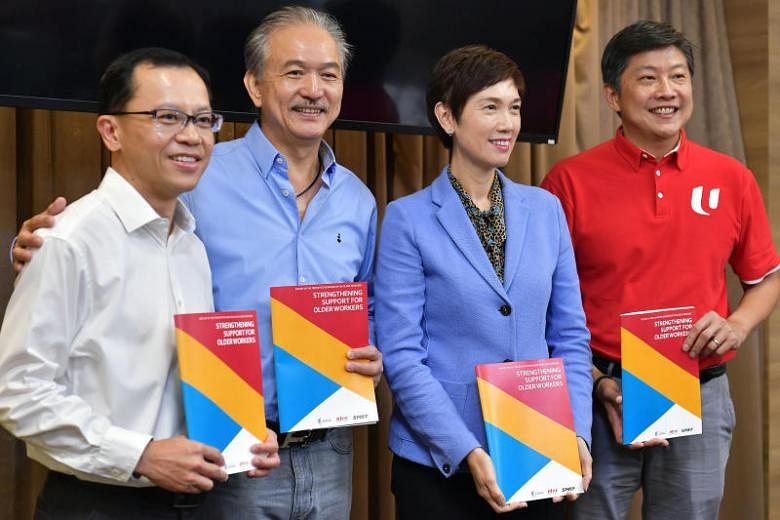SINGAPORE - The increases to the Central Provident Fund (CPF) contribution rates for older workers from Jan 1, 2021, onwards will come from both employers and employees.
The additional money will be paid into the Special Account, which accrues the highest possible interest among the CPF accounts.
These are among 22 recommendations made public on Monday (Aug 19) by the Tripartite Workgroup on Older Workers, all of which have been accepted by the Government.
The group released its report a day after Prime Minister Lee Hsien Loong said at the National Day Rally on Sunday that CPF contribution rates for older workers will be raised over the next decade or so, so that the full rate of 37 per cent is extended to those aged up to 60 before it tapers off, as proposed by the workgroup.
The retirement age and re-employment age ceiling will also be raised to 65 and 70 respectively, by 2030.
PM Lee added that a support package to help businesses adjust to these changes will be announced in next year's Budget.
The workgroup recommended that the Government provide wage offsets to accompany the higher age benchmarks, as the Special Employment Credit scheme expires at the end of next year. It also called for one-off wage offsets to mitigate the higher CPF contribution rates.

Manpower Minister Josephine Teo said that the timeline for the changes took into account the changing economic conditions and the need to provide businesses with some certainty.
The tripartite partners agreed that "fundamentally Singapore is labour constrained and that is not something that is cyclical in nature," she had told reporters last Saturday.
The number of Singaporeans aged 65 and over is projected to almost double from today and reach 900,000 by 2030, noted the workgroup.

Giving more details in its report, the workgroup said that subsequent increases in the retirement and re-employment ages should be in one-year increments.
For the first increase in CPF rates in 2021, employers and workers should each increase their contribution by 0.5 percentage point to 1 percentage point for workers aged 55 to 70.
For example, for someone who was 55 in January this year and earns $3,000, both he and his employer contribute 13 per cent, or $390 a month, to his CPF savings.
In January 2021, the contribution rates for each party would go up to 14 per cent, or $420 a month, assuming zero wage increments over the years. That works out to $360 more in contributions each a year for employer and employee.
Each subsequent increase in CPF rates will not exceed 1 percentage point for either workers or employers to minimise the impact on take-home pay and wage costs.
Both parties should be involved in the rate increases, in line with the tripartite approach to improving retirement adequacy, "with CPF contributions from employers and workers, and the Government providing progressive and risk-free interest rates to grow CPF savings", said the workgroup.
The 10-member group, which was formed in May last year to look at issues concerning older workers amid Singapore's ageing population, heard from more than 1,500 people, including young and old workers, union leaders and business leaders.
Its members and advisers also went on study trips earlier this year to Denmark, Japan, the Netherlands and Sweden, all of which plan to raise their retirement or re-employment ages.
The workgroup recommends a three-year increase in retirement and re-employment ages as the health-adjusted life expectancy at 62 has increased by more than three years since the retirement age was last raised in 1999.
Under the coming changes, employees hired at age 55 and over will only need to work for two years to be eligible for re-employment, instead of three. But the minimum re-employment contract duration will be kept to one year.
As for the timeline for the key changes, the workgroup noted that economic conditions have changed considerably since it started discussions in May last year and there may be more turbulence ahead.
"To help employers and workers prepare, there should be no ambiguity on the first moves in 2021 and 2022. Thereafter, the next moves should be decided through close tripartite consultations, with ample notice provided before they take effect," it said.
As the CPF rate increases have a direct impact on wage costs and take-home pay, the timeline to reach the full increase could be stretched beyond 2030 if economic conditions are poor, it said.
At the same time, labour chief Ng Chee Meng, an adviser to the workgroup, said at a press conference last Saturday that if economic conditions improve, the labour movement may request to shift the timeline earlier, "so that the workers' interests are taken care of ahead of what is planned".
The workgroup also called on employers to provide part-time re-employment opportunities and shift from group hospitalisation and surgical insurance to Medisave contributions, which are portable.
Singapore National Employers Federation (SNEF) president Robert Yap, who is also an adviser to the workgroup, welcomed the proposals but noted that they come with cost pressures on businesses.
"On behalf of employers, SNEF calls on the Government to provide financial measures to support employers to extend the employment longevity of the workforce as well as to help defray some of the cost increases of employing older workers over the next 10 years," he said.
Permanent Secretary for Manpower Aubeck Kam, who is the workgroup's chairman, said that the group is optimistic that Singapore can view the older population as an opportunity for future growth.
This is because the employment rate among older Singapore residents- at 58.8 per cent for full-time workers aged 55 to 64 - already compares very favourably to that of other developed countries. Also, older workers are very open to re-skilling for the future economy, and employers recognise that is in their interest and an imperative to adopt age-friendly practices, he said.
"We believe our proposals will build a Singapore where older workers can participate fully in the workforce without barriers and our businesses can succeed as progressive and inclusive enterprises," said Mr Kam.


